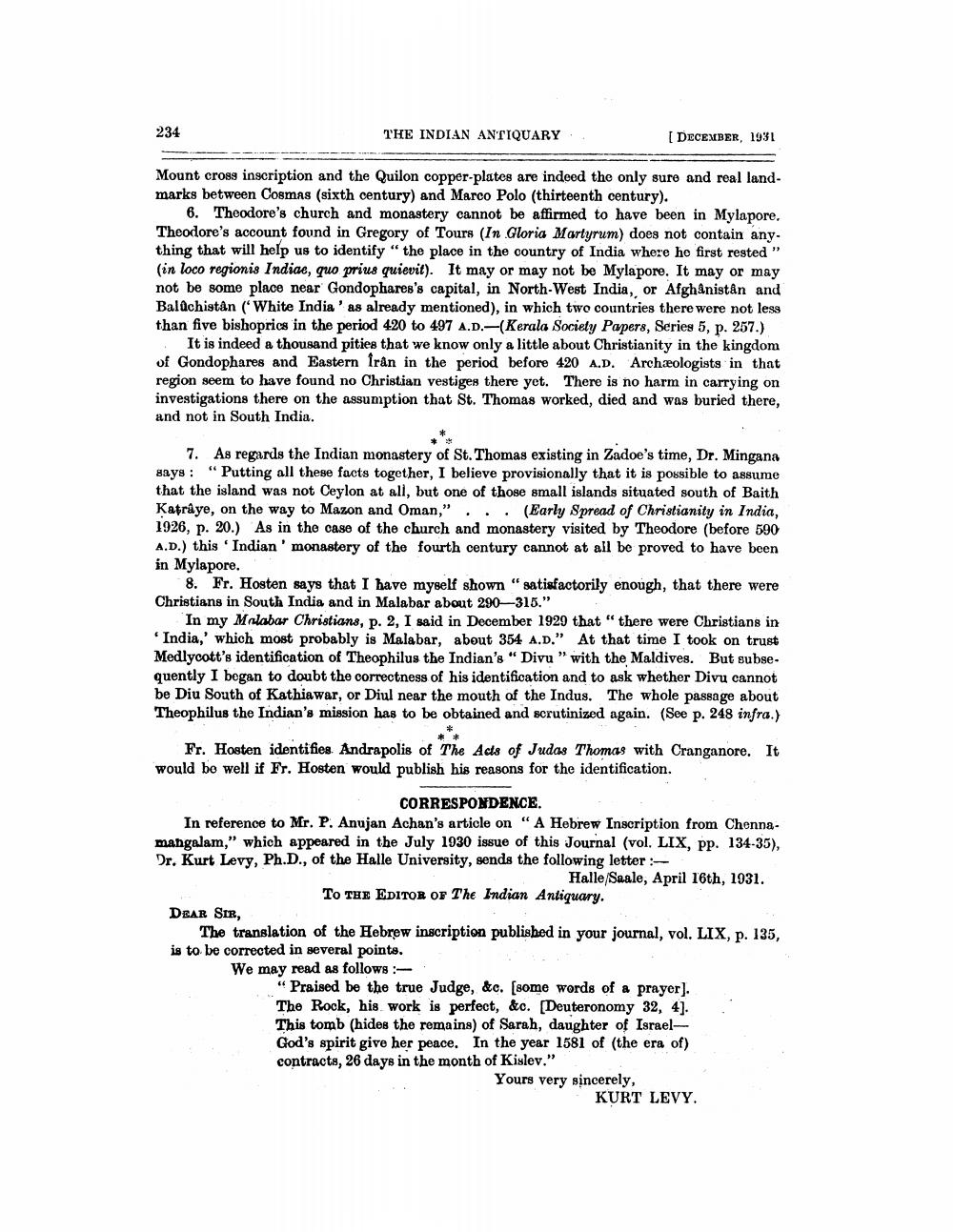________________
234
THE INDIAN ANTIQUARY
[ DECEMBER, 1931
Mount cross inscription and the Quilon copper-plates are indeed the only sure and real landmarks between Cosmas (sixth century) and Marco Polo (thirteenth century).
6. Theodore's church and monastery cannot be affirmed to have been in Mylapore, Theodore's account found in Gregory of Tours (in Gloria Martyrum) does not contain any. thing that will help us to identify "the place in the country of India where he first rested" (in loco regionis Indiae, quo prius quievit). It may or may not be Mylapore. It may or may not be some place near Gondophares's capital, in North-West India, or Afghanistan and Balachistan ("White India' as already mentioned), in which two countries there were not less than five bishoprics in the period 420 to 497 A.D.-(Kerala Society Papers, Series 5, p. 257.)
It is indeed a thousand pities that we know only a little about Christianity in the kingdom of Gondophares and Eastern Irån in the period before 420 A.D. Archäologists in that region seem to have found no Christian vestiges there yet. There is no harm in carrying on investigations there on the assumption that St. Thomas worked, died and was buried there, and not in South India.
7. As regards the Indian monastery of St. Thomas existing in Zadoe's time, Dr. Mingana says: "Putting all these facts together, I believe provisionally that it is possible to assume that the island was not Ceylon at all, but one of those small islands situated south of Baith Katraye, on the way to Mazon and Oman," ... (Early Spread of Christianity in India, 1926, p. 20.) As in the case of the church and monastery visited by Theodore (before 590 A.D.) this Indian' monastery of the fourth century cannot at all be proved to have been in Mylapore.
8. Fr. Hosten says that I have myself shown "satisfactorily enough, that there were Christians in South India and in Malabar about 290—315."
In my Malabar Christians, p. 2, I said in December 1929 that "there were Christians in India,' which most probably is Malabar, about 354 A.D." At that time I took on trust Medlycott's identification of Theophilus the Indian's "Divu " with the Maldives. But subsequently I began to doubt the correctness of his identification and to ask whether Divu cannot be Diu South of Kathiawar, or Diul near the mouth of the Indus. The whole passage about Theophilus the Indian's mission has to be obtained and scrutinized again. (See p. 248 infra.)
Fr. Hosten identifies. Andrapolis of The Acts of Judas Thomas with Cranganore. It would be well if Fr. Hosten would publish his reasons for the identification.
CORRESPONDENCE. In reference to Mr. P. Anujan Achan's article on "A Hebrew Inscription from Chennamangalam," which appeared in the July 1930 issue of this Journal (vol. LIX, pp. 134-35), Dr. Kurt Levy, Ph.D., of the Halle University, sends the following letter :
Halle/Saale, April 16th, 1931. TO THE EDITOR OF T'he Indian Antiquary. DEAR SIR,
The translation of the Hebrew inscription published in your journal, vol. LIX, p. 135, is to be corrected in several points. We may read as follows
"Praised be the true Judge, &c. (some words of a prayer). The Rock, his work is perfect, &c. (Deuteronomy 32, 4]. This tomb (hides the remains) of Sarah, daughter of Israel God's spirit give her peace. In the year 1581 of (the era of) contracts, 26 days in the month of Kislev."
Yours very sincerely,
KURT LEVY.




